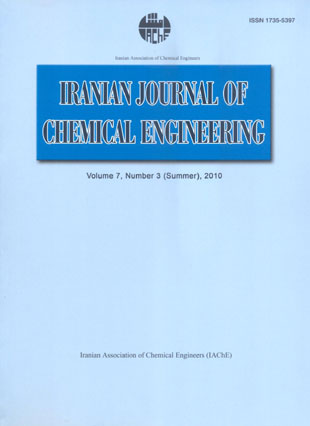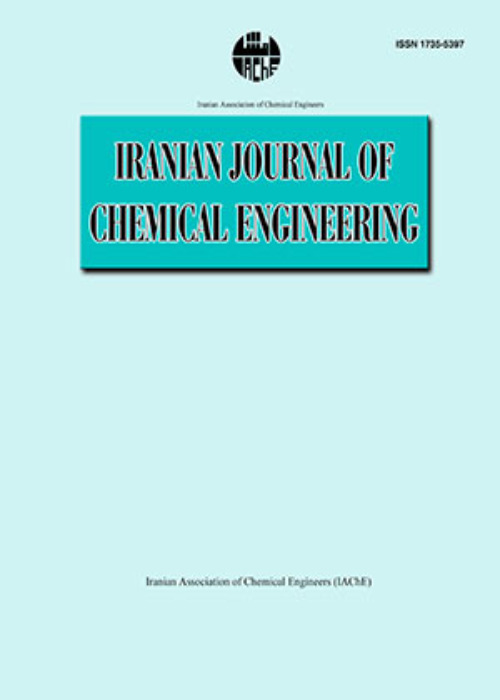فهرست مطالب

Iranian journal of chemical engineering
Volume:7 Issue: 3, Summer 2010
- تاریخ انتشار: 1389/05/01
- تعداد عناوین: 8
-
-
Page 3A static to dynamic approach to modeling Asphaltenes has been developed and validated. A new algorithm for static asphaltene modeling uses a multi-solid thermodynamics approach where the equality of fugacity for each component and phase is applied at equilibrium conditions. This is required for minimizing the Gibbs free energy. The fractal distribution function used for the splitting and characterization of heavy components provides accurate results. The precipitation and re-dissolution of asphaltenes are investigated for a relatively heavy crude oil from an Iranian field. A series of experiments are designed and carried out quantitatively to obtain the permeability reduction in a slim tube. Using a dynamic reservoir simulator, a 3-dimensional asphaltene model is developed to simulate the precipitation, flocculation, deposition and its impact on permeability in a slim tube. With this approach, the asphaltene is defined as a set of component(s) that can precipitate depending on their molar percentage weight in the solution. The simulated permeability reduction due to asphaltene deposition shows good agreement with our experimental data
-
Page 17Oily wastewaters and Oil–in-water emulsions are two of the major pollutants of the environment. Ultrafiltration (UF) membranes play an important role in the treatment and reuse of oily wastewaters. Fouling of UF membranes is typically caused by inorganic and organic materials present in wastewaters that adhere to the surface and pores of the membrane and result in the deterioration of performance with a consequent increase in energy costs and membrane replacement. In the experiments, polyacrylonitrile (PAN) and outlet wastewater of the API (American Petroleum Institute) separator unit of Tehran refinery as membrane and feed were used, respectively. Fouling and cleaning experiments were performed with oily wastewater and selected cleaning agents using a laboratory scale cross flow test unit. The results showed that metal chelating agent (ethylene diamine tetra acetic acid disodium salt-2-hydrate (EDTA)) and an anionic surfactant (sodium dodecyl sulfate (SDS)) were able to clean the fouled UF membrane effectively by optimizing chemical (pH) and physical (cleaning time, cross flow velocity (CFV) and temperature) conditions during cleaning. Flux recovery and resistance removal were found to improve with increasing CFV, temperature, pH, cleaning time and concentration of the cleaning chemicals. In this paper, the cleaning mechanism is also investigated.
-
Page 29In this work, the behavior of a single-type industrial methanol reactor while the 5% CO was injected into the 95% of feed was investigated. For the dynamic simulation purposed, a heterogeneous one-dimensional model has been developed in the presence of long term catalyst deactivation. The performance of the reactor with CO injection to the feed entrance was investigated and the product and reactant mole fraction profiles of the aforesaid reactor were compared with that of a conventional single type (CMR) and membrane methanol reactor (MMR). The simulation results represent 14.24% and 22.93% enhancement in the yield of methanol production in comparison with MMR and CMR, respectively, while 5% CO was injected into the 95% of the feed. Also, by CO injection to the feed, water production during methanol synthesis via CO2 hydrogenation which accelerates the catalyst deactivation and reduces methanol production rate, is reduced greatly. Additionally, nowadays CO is an important cause of pollution and a hazardous material in many industrial processes and using it in these processes is one of the ways to solve the pollution problem.
-
Page 49In the present work, a population balance model is used to predict dynamic evolution of droplet/particle size distribution in non-reactive liquid-liquid dispersions and reactive liquid (solid)-liquid suspension polymerization systems. The effect of dispersed phase hold-up and agitation rate on droplet/particle size and droplet/particle size distribution are investigated. The cell average technique is applied for solving the population balance equation. Predictive capability of the presented model is demonstrated by comparison of model predictions with experimental data regarding the average mean diameter for non-reactive liquid-liquid dispersions and the free-radical suspension polymerization of styrene.
-
Page 61Enhanced design strategies in the industrial cracking furnaces are of practical interest for petrochemical industries. For such engineering purposes the exact simulation of temperature and flow fields in the furnace is mandatory. In this paper, a study was conducted to simulate 3D flue gas flow pattern and temperature field in the radiation section of an industrial cracking furnace in order to improve the design of the steam cracking furnaces, employing the computational fluid dynamics (CFD) technique. The steady-state Reynolds averaged Navier–Stokes (RANS) equations were solved, in a finite volume scheme for a turbulent premixed flow applying the renormalization group (RNG) version of the model, together with global combustion kinetics for methane-hydrogen-air. Calculation of the Damkhöler number and optical-thickness was conducted to identify the appropriate methods for the numerical modeling of radiation and turbulence-chemistry interaction phenomena. The predicted results match the literature data quite well. The validated numerical procedure was then employed to investigate alternative design attributed to different burner locations. The alternative design resulted in a more uniform temperature profile on the reactor tubes as well as lower peak flame temperature.
-
Page 74An integral reactor-based kinetic model for the selective reduction of nitric oxide over Cu-Zn/ZSM-5 washcoated monolithic catalysts is reported. The active component was washcoated onto a 400 cpsi ceramic monolithic substrate at a loading of 23.6 wt. % usage 2,000 ppm iso-butane was used as the reductant. High activity without significant pressure drop was achieved at a GHSV of 16,000 h-1. Third order polynomial satisfactorily fitted the activity versus space time data and a low activation energy of +30.3 kJ/mol was obtained. The applicability of the model was demonstrated within 300-400 ºC and space time of 0.12-0.94 s.
-
Page 81
Drying behavior of sugar beet was investigated in a bench scale fluidized bed dryer with an energy carrier (3 mm glass beads) and a freeze dryer. The effect of the type of dryer (fluidized bed dryer & freeze dryer) on the rate of drying and properties of dried sugar beet were studied. It was found that drying could be useful for the storage of sugar beet for a long time before processing, but the removal of more than 90% of its initial water content is necessary for the dried sugar beet to conserve its sugar content and other properties during storage. The results of experiments in two different dryers showed that drying time in a fluidized bed dryer with energy carriers is much less than that of a freeze dryer, but the dried matter obtained by the freeze dryer has a better appearance in comparison to fluidized bed dryer. Also, the shrinkage of drying material with a change of moisture content was investigated and it was seen that a linear relation with reasonable error between these two variables was evaluated. The results are useful for mathematical modeling of the process.
-
Page 88


